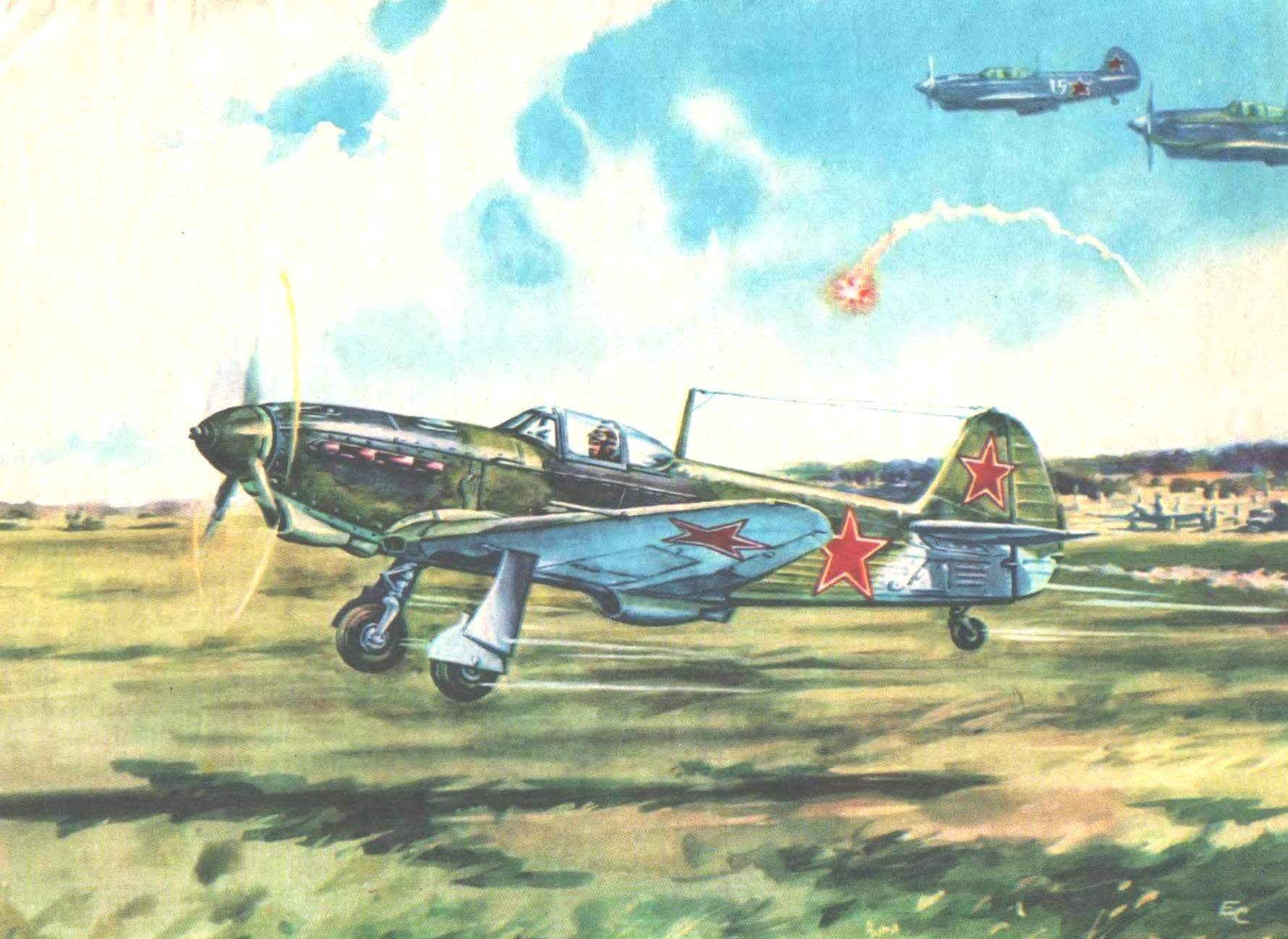
 In early 1939 the Soviet government put before the Soviet aircraft the task to accelerate the creation of new samples of military equipment. Special attention was paid to the fighters. That’s why for developing them came from the leading aircraft.
In early 1939 the Soviet government put before the Soviet aircraft the task to accelerate the creation of new samples of military equipment. Special attention was paid to the fighters. That’s why for developing them came from the leading aircraft.
Considerable success was achieved, the team which was headed by A. S. Yakovlev. The designers used the experience of creating a high-speed sport monoplane I-7 (AIP-7), which in 1932 with an engine capacity of 450 HP reached a high speed of 330 km/h.
The aircraft, designated I-26, in January 1940 first appeared on the airfield, and in March, the test pilot of KB Alexander Yakovlev Yu. I. Piontkovsky lifted him into the air. In the second flight, the plane has a top speed of 587 km/h at an altitude of 5100 m. He had a good flight handling qualities, was easy to manage and with the most technologically.
Obtained flight characteristics allowed 27 April 1940, make the decision to start pre-production before the end of the factory ignorance.
The test machine continued P. Y. Petrovi, who flew all the Yak to the Yak-9D.
10 Jun 1940 M-26 experimental series were transferred to the state tests in the FDI of the air force. The famous test pilot S. P. Suprun said: “the Plane is valuable for its ease of piloting. It is urgent to start the plane in the series.”
The approaching war forced to boost production rates. So, until the late 1940s , the air force was transferred to the 64 aircraft in the first half of 1941 year — 335 to the end of the year — another 1019 machines. During the war years — 8721 plane.
Yak defended the skies of Moscow in 1941. They were armed with 4 of the 11 fighter aviation regiments that were part of the air defense system of Moscow.
On the Yak-1 and Yak-1M began his fighting way of the French squadron “Normandie” and the regiment “Warsaw” 1st fighter division of the Polish army. This connection on 19 January 1945 participated in the liberation from Nazi invaders of the capital of Poland.



Yak-1:
1 — handle
2 — lift handle seat (black)
3 — Cup seat (ser.)
4 — back (ser., upholstery — black)
5 — bulletproof glass
6 — handle stopper-spike (black)
7 — front antenna
8 — switch Board (worms.)
9 — trailer PBP-1A
10 — control knob ventilation cockpit
11 — the steering wheel of the rudder trimmer (black)
12 — instrument panel (black)
13 — the handle of the petrol tap (black)
14 — stick a neutral gas (black)
15 — fire partition
16 — pedals control rudder
17 — podpalennye site
18 — control cable rudder
19 — line of the cab floor
20 — knob pitch control
21 — handrail (ser.)
22 — pen mechanical reloading gun (black)
23 — steering wheel controls alignment
oil cooler (black)
24 — fold ventilation of the cabin
25 — valve on-Board charging (black)
26 — cylinder valve network (brown)
27 — the valve of the emergency tank (cu.)
28 — tap release and cleaning landing flaps (Gol.)
29 — the sector normal gas (yellow.)
80 —sector high-rise strip (black)
31—the handle of the release gear (black)
32 — sector boost (black)
33 — button electric alarm chassis
34 — toggle-electric alarm chassis
35 — air valve emergency landing gear (kr.)
36 — trigger: UBS (upper), ShVAK (lower)
37 — crane emergency opening locks of the upper chassis (brown)
38 — the steering wheel of the leaf vodoradiatora (black)
39 — arm oil injector
40 — oxygen device KPA-3 bis
41, a syringe for starting the motor and feeding gasoline to the carburetor
42 — tap motor starting (black)
43 — handle alarm reset light (cu.)
44 — the castle of the lantern
45 — extension of switchboards (black)
46 — trafaretka “the Order of withdrawal from a spin”
47 cassette with a correction schedule deviation speed and altitude
48 — the installation location of the radio transmitter
49 — cartridge for missiles
50 — techstroy indicator (pointer oil temperature, oil pressure and pressure of gasoline)
51 — turn signal and declination
52 — voltammeter
53 — tap cleaning and landing gear
54 — stopper of the crane chassis
55 — button ignition {vibrator)
56 — switch magneto
57 — pen pneumopericardium gun
58 — pressure gauge compressed air
59 — two-point speed indicator US-800
60 — altimeter 10,000 m
61 — controller electropodcast sight
62 leather safety cushion
63 — compass KI-10
64 — pointer.
65 centrifugal tachometer
66 — stencil: “Takeoff and landing — a crutch to stall. Taxiing — rastport”
67 — watch ABP
68 — high pressure manometer
69 — warning lamps chassis
70 — aerothermal water
71 — hatch of swedesboro UBS
72 — PVD
73 — pipe to install the lift
74 — ANO white
75 — the tail wheel 300X125
76 — strut tail wheel shock absorber
77 — brace
78, 79 — flap Sassa
80 — lock chassis
81 — pneumatic cylinder of the landing gear
82 — visual position indicator chassis
83 unloading pneumatic cylinder
84 — breaking brace 65 — Polovinka chassis
86 main wheel 600X180
87 — ANO green
88 — Luke rocking Aileron
89 — hatch compartment hillsoboro
90 — Luke rocking trimmer 91—Luke crane oil cooler
92 — bensinger
93 — Luke on the mouth of the gas tank
94 — the water drain from vodoradiatora.
95 — ANO red
96 — Luc over the neck of the oil tank
97 — fencing of the exhaust nozzles
98 — exhaust pipe
99 — giltedged UBS
I. external suspension Bracket.
II. The thrust of the Aileron.
III. The serial number of the aircraft.
The excellent fighting qualities of Jacob allowed the Soviet heroes of the pilots to beat even a superior force of the enemy. On March 12, 1942, the newspaper “Pravda” and “Krasnaya Zvezda” reported about the battle of the seven Yak-1 under the command of captain B. Eremina eighteen vs Me-109, six Ju-87 and one Ju-88. Our pilots, without suffering losses in this battle, shot down five Me-109 and two Ju-87, drawing the enemy to flight.
In the course of serial production of Yak-1 has been repeatedly modernized. 200 HP increase in the engine power.
Air screw VISH-61 with manual pitch control on the Yak-1M the last series was replaced by the automatic variable-pitch propeller VISH-105SV, which increased the maximum speed, ceiling and rate of climb of the aircraft. To facilitate the plane the Yak-1 late series Yak-1M (unlike the Yak-1 first series) removed the mechanism for cleaning the tail wheel. This is reflected in figure A. Makarov. Altered wing air intakes of the supercharger. Changed weapons. So, the Yak-1M instead of two ShKAS machine guns-7,62 mm (the Yak-1 of the first series) on the left of the engine has one heavy machine gun UBS 12.7 mm.
In the production process have changed the cabin equipment, the number and configuration of flaps, gear, design polovinki, has installed the radio. On the Yak-1 in some series in the left wing mounted landing light.
The color of the screw And-26 and the Yak-1 first series: black matte back surface and polished unpainted — front. The polished surface has improved the aerodynamics of the propeller, but unmasked the plane in flight, so Yaks subsequent series had the matte black blades with yellow tips.
The experience of combat use of the Yak-1 had demanded some changes in the design of the aircraft. So, at the suggestion of the pilots of the Stalingrad front, the Saratov aviation plant began producing aircraft with reduced upper fairing, cabin Windows were replaced with light, improve review rear hemisphere. Improvements helped to reduce the takeoff weight of the machine to 2660 kg (2960 kg I-26). As a consequence, the rate increased to 599.5 km/h (580 km/h the Yak-1 of the first series), the rate of climb near the ground increased from 18 to 20 m/sec, improved maneuvering characteristics.
283 the commander of the regiment of the 16th air army Colonel V. A. Kitaev at the end of September 1942 he reported to the commander: “Our plane — lightweight Yak-1 is not only not inferior to enemy fighters, but in many ways surpasses them at altitudes up to 2500 m on both horizontal and vertical maneuver.” From the end of 1942, the Saratov aircraft plant completely switched to production of aircraft Yak-1.
At the initiative of Yakovlev design Bureau, and front-line pilots was conducted and other improvements of the aircraft. Strengthened the armament of the aircraft, improved flight quality a formidable fighting machine.
The design of the Yak-1 combined: truss frame of the fuselage is welded from hromansilevyh pipes, duralumin plating of the bow consists of separate lids attached to the frame by locks ZUSHI. The side walls of the rear fuselage have a fabric covering on the wooden stringers. The upper and lower gargrota the rear fuselage is a wooden frame, sheathed with plywood. Motor mount is integral with the fuselage of the farm that high-tech, but somewhat difficult to service the engine.
The wing is two-spar wooden structures, all-in-one, with an area of 17.15 m2. Box-section spars of pine slats and plywood walls, variable in scale thickness from 10 to 3 mm. Rib firmenneuling type. The front longitudinal is 32% of the chord at the root and at 27% of chord at the end of the wing rear spar, respectively, 65% and 60%. The attachment points of the wing to the fuselage is located on the side members and the toe wing. Between the spars installed dural farm, which carries the node chassis.
Plywood sheathing wing smykaetsya on the front and rear spars. The bracket cover into the casein glue and screws. Wing surface covered with calico, plastered and painted. On the lower surface of the wing between spars features 4 large power caps, through which are mounted gas tanks. The ailerons consist of a duralumin frame and fabric covering. Adjustable on the ground, the trimmer-knife is mounted only on the left Aileron. Wing-mounted flaps all-metal riveted construction. The stabilizer beam, wooden construction, comprising two box-spars, stringers and ribs. On the front and rear spars is set by two welded attachment of the stabilizer to the farm of the fuselage. Paneling — birch plywood thickness of 2.5 mm. of the Elevator from the two halves has a duralumin frame and fabric covering. On the left half of the Elevator installed operated trimmer. The wooden keel, removable, consists of two box-spars, stringers, ribs, end of the rim. Sheathing plywood. The rudder is suspended at three points and the keel, has an aluminum frame with fabric covering. To the trailing edge of the rudder attached knife.
Main chassis — single column — consists of a spring strut of a wheel and a breakable strut. Lifting and landing gear pneumatic.
The Yak-1 set of pneumatic unloading cylinder, rotating on an axis attached to the spar. It helps lift the chassis and DAMPS release. In the retracted position of the strut is held by special lugs on the lower end of the welded polovinki in the castle, mounted between 1 and 2 ribs of the wing. The main wheels are equipped with brakes.
Strut of the crutch is attached and the nodes located at the bottom of the strut tail farm of a fuselage. The tail wheel non-braking and equally fluent, with a lock on takeoff and landing.
On the Yak-1 was installed 12-cylinder liquid-cooled engine VK-105PF, designed by V. Y. Klimov capacity of 1240 HP three-blade metal variable-pitch propeller VISH-61ПØ3 and had manual adjustment of the blade pitch (on some series installed screw VISH-105SV, having automatic adjustment of the step). The propeller hub, through which passed the barrel of a gun, had the ratchet to start the meter from autostarter and closed easily removable cook. On-Board weapons consisted of motor gun MP-20 (ShVAK) caliber 20 mm machine gun synchronised UBS 12.7 mm installed on the left of the engine. On some series of Yak-1 provided for the suspension of missiles and bombs.
To protect the pilot set the rear bulletproof glass and armored seat back.
The simplicity and reliability of the Yak-1, successful experience in the production and operation in combat conditions allowed in the future to create even more advanced machine based on it, such as the Yak-3, Yak-7 and Yak-9.
Drawings of the plane made the YAK-1, dated December 15, 1942, the Saratov aviation plant, and are now deposited in the Saratov regional Museum of local lore.
YAK -1. KEY FEATURES
Wing span, m…………………10
Length the greatest, m…………8,42
Wing area, m2 ……………12,15
The wing profile is Clark up-2 (14% root, 10% at the end)
Take-off weight, kg………………….2600
Landing speed, km/h…..120
Practical ceiling, m………10 700
V. KOLPAKOV, engineer



